Thursday, February 24th 2011

Thunderbolt Technology: The Fastest Data Connection to Your PC Just Arrived
Intel Corporation today announced the availability of Thunderbolt technology, a new high-speed PC connection technology that brings together high-speed data transfer and high-definition (HD) display on to a single cable. Running at 10 Gbps, Thunderbolt technology can transfer a full-length HD movie in less than 30 seconds. This Intel-developed technology is coming to market through a technical collaboration with Apple, and is available first on Apple's new line of MacBook Pro laptop computers.
The vision for Thunderbolt technology (formerly codenamed "Light Peak") is to move media faster, simplify connections between devices, and foster new and exciting ways to build and use PCs. Combining high-speed data and HD video connections together onto a single cable is instrumental to achieving that vision. Thunderbolt technology delivers this via two communications methods, or protocols -- PCI Express for data transfer and DisplayPort for displays.PCI Express has the flexibility to connect to almost any type of device, and DisplayPort can drive greater than 1080p resolution displays and up to eight channels of audio simultaneously. Thunderbolt technology is compatible with existing DisplayPort displays and adapters. All Thunderbolt technology devices share a common connector, and let individuals simply daisy-chain their devices one after another, connected by electrical or optical cables.
Thunderbolt technology is designed to meet the demands of serious HD media creators. For example, videographers can unleash their creativity using high-bandwidth audio and video capture/mixing devices, and get both low latency and highly-accurate time synchronization for real-time processing. At 10Gbps, larger media files are transferred faster so there's less time spent waiting to watch and edit videos. Data can be backed up and restored quicker, so there's less waiting for archived content. For mobile PC users, it means having a single connector on their ultra-thin laptop that extends their high-speed media and HD display capabilities at home or in the office. Thunderbolt technology is complementary to other I/O technologies that Intel continues to support."Working with HD media is one of the most demanding things people do with their PCs," said Mooly Eden, general manager, PC Client Group, Intel. "With Thunderbolt technology, Intel has delivered innovative technology to help professionals and consumers work faster and more easily with their growing collection of media content, from music to HD movies. We've taken the vision of simple, fast transfer of content between PCs and devices, and made it a reality."
"We're thrilled to collaborate with Intel to bring the groundbreaking Thunderbolt technology to Mac users," said Bob Mansfield, Apple's senior vice president of Mac Hardware Engineering. "With ultra-fast transfer speeds, support for high-resolution displays and compatibility with existing I/O technologies, Thunderbolt is a breakthrough for the entire industry and we think developers are going to have a blast with it."
Thunderbolt technology is powered by an Intel controller chip, and uses a small connector suitable for mobile devices that will be included in products supporting the technology. Several innovative companies have announced Thunderbolt technology-based products, or currently plan to support Thunderbolt technology in upcoming products, including Aja, Apogee, Avid, Blackmagic, LaCie, Promise, and Western Digital. Intel is working with the industry on a range of Thunderbolt technology-enabled products including computers, displays, storage devices, audio/video devices, cameras, docking stations and more.
The vision for Thunderbolt technology (formerly codenamed "Light Peak") is to move media faster, simplify connections between devices, and foster new and exciting ways to build and use PCs. Combining high-speed data and HD video connections together onto a single cable is instrumental to achieving that vision. Thunderbolt technology delivers this via two communications methods, or protocols -- PCI Express for data transfer and DisplayPort for displays.PCI Express has the flexibility to connect to almost any type of device, and DisplayPort can drive greater than 1080p resolution displays and up to eight channels of audio simultaneously. Thunderbolt technology is compatible with existing DisplayPort displays and adapters. All Thunderbolt technology devices share a common connector, and let individuals simply daisy-chain their devices one after another, connected by electrical or optical cables.
Thunderbolt technology is designed to meet the demands of serious HD media creators. For example, videographers can unleash their creativity using high-bandwidth audio and video capture/mixing devices, and get both low latency and highly-accurate time synchronization for real-time processing. At 10Gbps, larger media files are transferred faster so there's less time spent waiting to watch and edit videos. Data can be backed up and restored quicker, so there's less waiting for archived content. For mobile PC users, it means having a single connector on their ultra-thin laptop that extends their high-speed media and HD display capabilities at home or in the office. Thunderbolt technology is complementary to other I/O technologies that Intel continues to support."Working with HD media is one of the most demanding things people do with their PCs," said Mooly Eden, general manager, PC Client Group, Intel. "With Thunderbolt technology, Intel has delivered innovative technology to help professionals and consumers work faster and more easily with their growing collection of media content, from music to HD movies. We've taken the vision of simple, fast transfer of content between PCs and devices, and made it a reality."
"We're thrilled to collaborate with Intel to bring the groundbreaking Thunderbolt technology to Mac users," said Bob Mansfield, Apple's senior vice president of Mac Hardware Engineering. "With ultra-fast transfer speeds, support for high-resolution displays and compatibility with existing I/O technologies, Thunderbolt is a breakthrough for the entire industry and we think developers are going to have a blast with it."
Thunderbolt technology is powered by an Intel controller chip, and uses a small connector suitable for mobile devices that will be included in products supporting the technology. Several innovative companies have announced Thunderbolt technology-based products, or currently plan to support Thunderbolt technology in upcoming products, including Aja, Apogee, Avid, Blackmagic, LaCie, Promise, and Western Digital. Intel is working with the industry on a range of Thunderbolt technology-enabled products including computers, displays, storage devices, audio/video devices, cameras, docking stations and more.
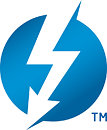
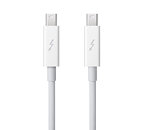
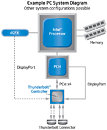
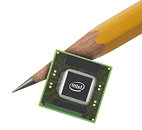
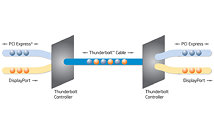
76 Comments on Thunderbolt Technology: The Fastest Data Connection to Your PC Just Arrived
Is there a shortage of design ideas for simple logos for connectors? Seriously though, that means something like 'electric shock'.
I wonder how many n00bs are going to get zapped thinking it's "thunderbolt" and how soon after the law suits will come. I mean... if you can sue Nintendo (Wii) for throwing your control through the TV, then Intel is in for some fun with this...:nutkick:
i want magic like the following:
PC is connected to HDTV via DP/TB.
TV is connected to speakers, games consoles, and all else shiny via DP/TB.
i want them to link up like HDMI can these days - so that those devices can all control each other. the consoles get internet acess via the networked DP devices (PC, in this case). the PC, TV and consoles can all control the volume on the speakers.
I WANT A MAGIC ALL IN ONE CONNECTION THAT TRULY INTEGRATES DEVICES. If TB doesnt deliver this, i'll just have to wait another 15 years or so, i guess...
On a serious note though, at least this will help Displayport 'infiltrate' the market at last.
However, if Intel intends to drive this in a direction as to challenge Ethernet, they're going to make Cisco and the like go ballistic!
I want high speed WIRELESS connections please!!
The technology is there why their not utilizing it is beyond me :rolleyes:
The maximum you'd get with wireless is 300-500Mbps. That's slower than USB 2.0.
I think we would be a little further along than 300-500Mps
No thanks. I'm not even using a 802.11n router in house, not near the baby anyways. ;)
Click to read article
I also don't buy into the "but USB 3.0 is a familiar-looking port with backwards compatibility" argument. If your devices need 5 Gb/s bandwidth, you're anyway going to create a hardware environment around it (i.e. buy a USB 3.0 controller card and compatible devices). So Thunderbolt is no more "unique" than USB 3.0. Besides having 10x less bandwidth doesn't make backwards compatibility a big factor. So USB 3.0's backwards compatibility isn't a huge plus.